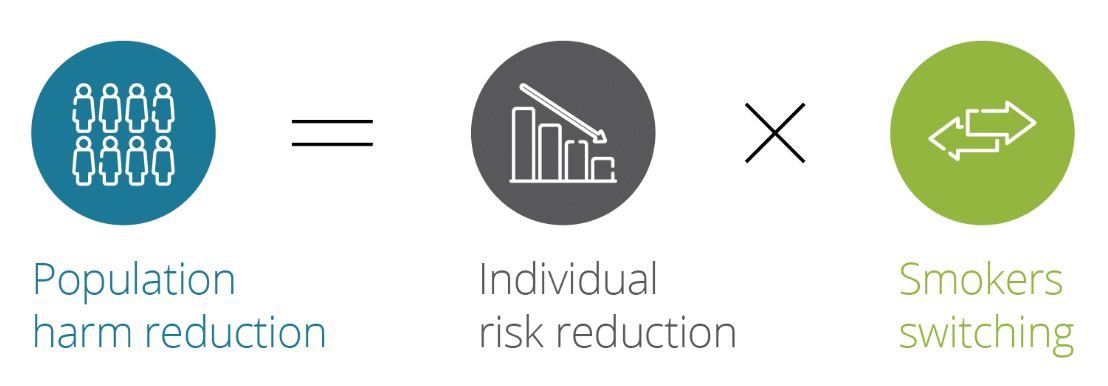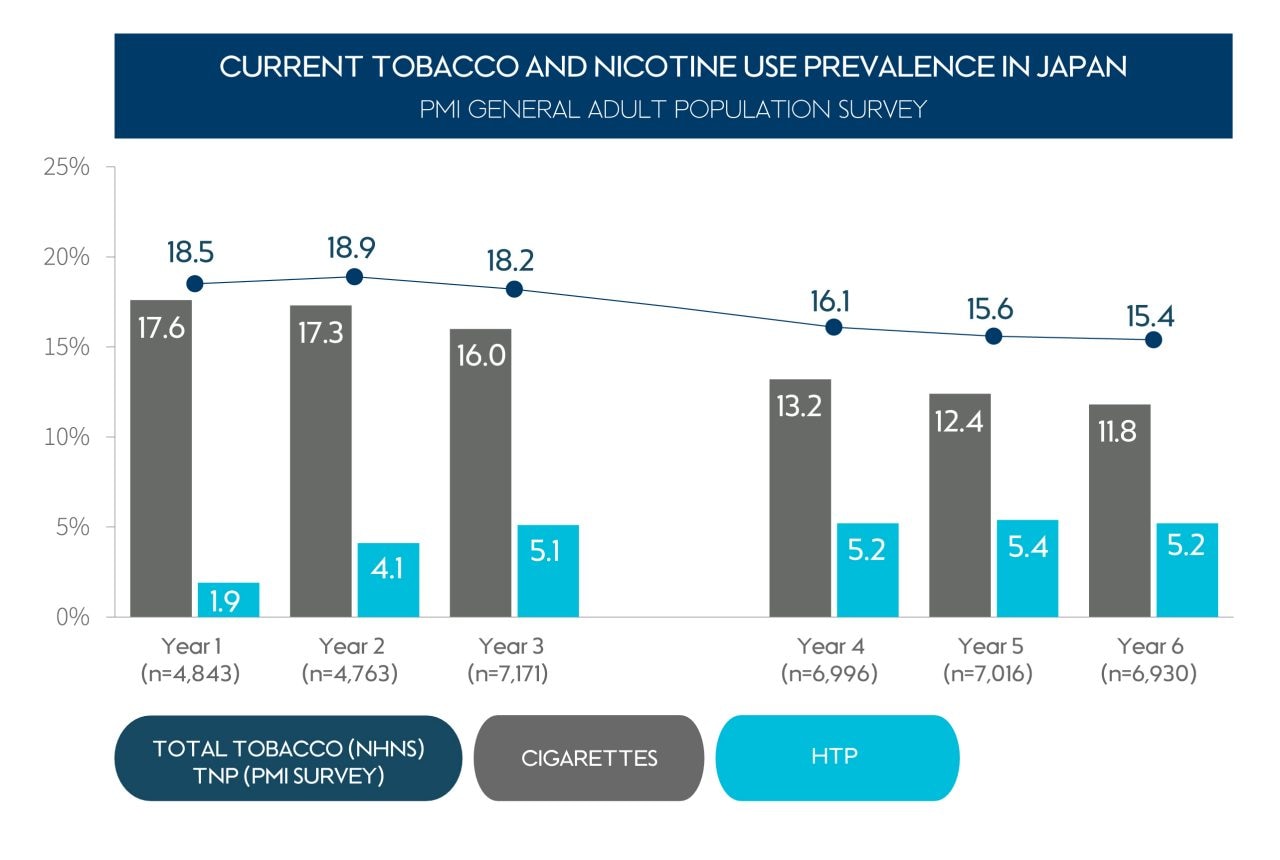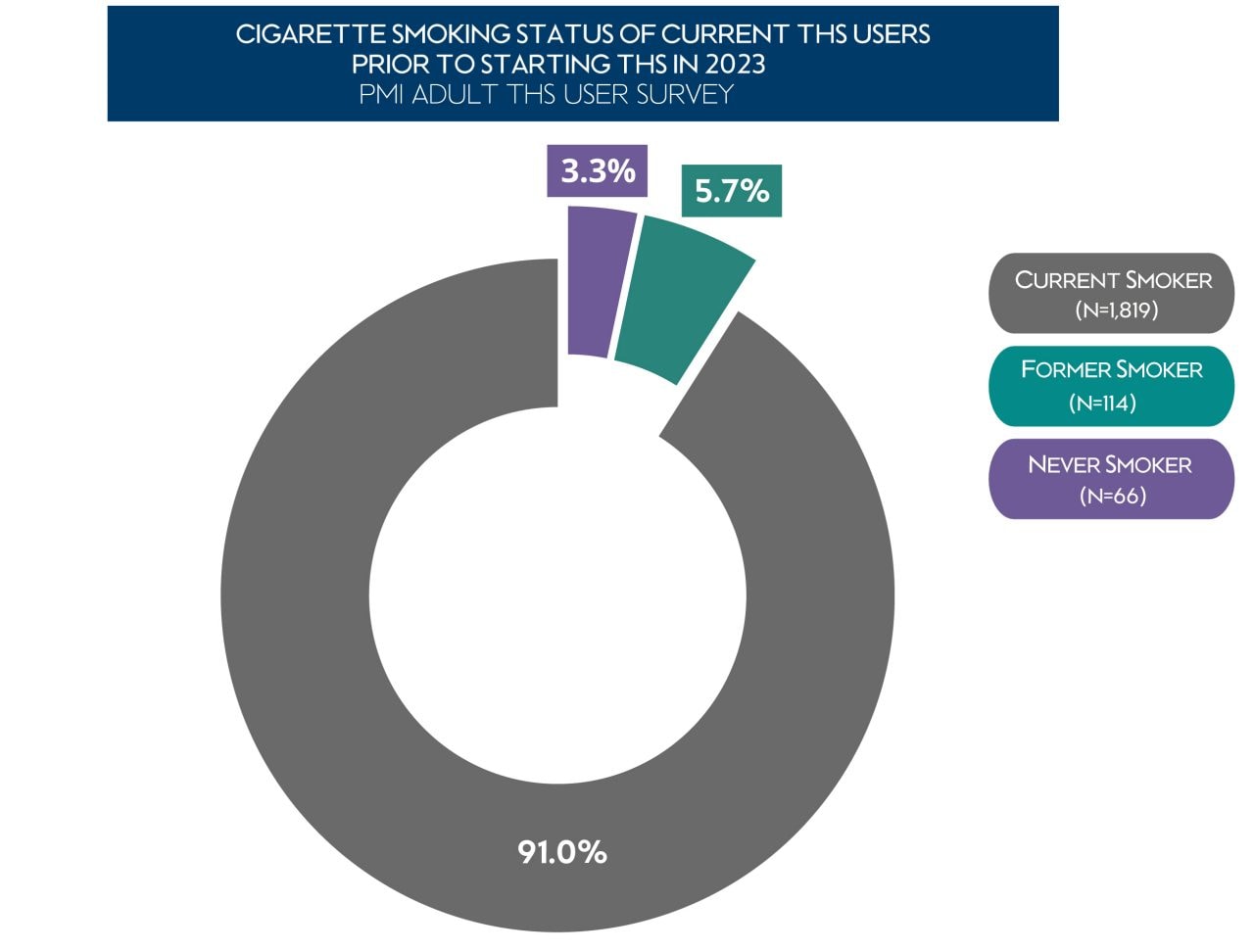In recent years, alternatives to cigarettes, including smoke-free products, have been introduced in multiple countries around the world. In Japan, for example, many adult smokers have transitioned to using HTPs instead of continuing to smoke cigarettes. Other countries, including the U.K. and New Zealand, have promoted the switch to vaping products for those trying to abandon smoking as part of their national public health policy.
In Sweden, the smoke-free oral tobacco product snus has already replaced cigarettes among adult males as the most widely used tobacco product. This transition has contributed to a decrease in smoking prevalence among Swedish men and, according to some literature, suggests a decrease in tobacco-related mortality. In addition, data from the 2022 Japanese National Health and Nutrition Survey (NHNS) show a continued decline in smoking prevalence after the introduction of HTPs in 2014 and their subsequent widespread adoption by millions of smokers in Japan.
However, in order for cigarette alternatives to contribute to public health in accordance with the concept of tobacco harm reduction, it is important not only to scientifically demonstrate that these products are less harmful than smoking but also that they are accepted by current adult smokers who would otherwise continue to smoke. At the same time, the use of these alternative products by youth and nonsmokers needs to be minimized.
Successful harm reduction requires that adult smokers be offered a range of less harmful alternatives so that acceptance by users can be best fulfilled.
In this interview, Dr. Karina Fischer, Manager Regulatory Consumer Research at Philip Morris International (PMI), discusses a representative 6-year study conducted by PMI on tobacco product prevalence and usage patterns in Japan. She presented results of the first 5 years of this study at a scientific conference held by the Japan Society of Japan Health and Medical Behavioral Sciences in Osaka, and additional results in 2024 at the Nicotine and Tobacco Science Conference at Medical University of South Carolina, Charleston, U.S. Below, Karina describes the findings of the study and her opinion on whether HTPs have the potential to benefit public health.
Dr. Karina Fischer
Manager Regulatory Consumer Research
Dr. Fischer helps to lead the design, development, implementation, analysis, and reporting of postmarket studies by applying existing or innovative, scientifically robust theories and practices.
What are the main alternatives to cigarettes in Japan?
In order to reduce the health risks associated with cigarette smoking, new, scientifically substantiated smoke-free products, such as HTPs and e-cigarettes, have been developed and marketed for several years, based on the concept of tobacco harm reduction. By only heating and not burning tobacco, scientifically substantiated HTPs generate significantly reduced emissions of harmful chemicals compared with cigarettes. In addition, a recent real-world study conducted by PMI has found that subjects who switched from cigarettes to THS for at least 2 years showed favorable differences in nine biomarkers of potential harm (BoPH), compared with current smokers. The results were similar to those observed in former smokers and are in line with results from earlier studies. Therefore, scientifically substantiated HTPs represent a reduced-risk option for adult smokers who would otherwise continue to smoke cigarettes.
Worldwide, e-vapor products, such as e-cigarettes, are the most popular alternatives to cigarettes while, in Japan, HTPs are the most accepted alternative to cigarettes. Due to laws and regulations (Pharmaceuticals and Medical Devices Act), e-cigarettes with nicotine are not available for consumers in Japan. An approval is required to sell liquids that contain nicotine, and there are currently no approved liquids, so e-cigarettes sold in Japan do not contain nicotine.
How can we know whether the increasing availability of HTPs will indeed contribute to tobacco harm reduction and benefit public health?
HTPs are still relatively new, and so long-term prospective data are limited. Our own THS, commercialized as IQOS, was launched nationwide in Japan beginning in 2015.
We understand that there are concerns regarding the individual and public health impact of HTPs. For example, some of the initial concerns included:
- The advent of HTPs may increase the overall tobacco product consumption in Japan.
- The use of HTPs together with cigarettes may not benefit individual and public health.
- Users who have never used tobacco products may start using HTPs.
- The introduction of HTPs may prevent smokers who want to quit cigarettes from doing so.
These are all legitimate concerns, which need to be discussed and addressed. This is why rigorous scientific studies―and in particular postmarket studies―need to be conducted and analyzed.
You presented the 6-year results of a repeated study on tobacco product use in Japan at an academic conference, right?
Yes, I had the opportunity to present our 6-year trend data on the evolution of tobacco use habits, including HTPs, in Japan at the Nicotine and Tobacco Science Conference (October 28, 2024, at Medical University of South Carolina, Charleston, U.S.). I believe that the results of this 6-year study can respond to some of the concerns about HTPs mentioned earlier.
Learn more about PMI’s research to assess the evolution of tobacco product use habits:
Now, could you please give us an overview of PMI’s HTP research conducted in Japan
This is an ongoing, yearly repeated, representative cross-sectional study that examines the usage prevalence and usage patterns of tobacco products among the general adult population (aged 20 and older) in Japan. Since 2016, we sampled and surveyed 4,000 to 7,000 participants every year. We have also surveyed adult users of THS over the same period of time. To ensure the ethical conduct and research integrity of the study, including an independent assessment and objectivity of the research, the research protocol was reviewed and approved by the Hakata Clinic Institutional Review Board in Fukuoka, Japan. Regarding the design of the study, both the sampling method (stratified multi-stage random sampling) and the separate measurement of cigarette smoking and HTP usage follow those of the Japanese NHNS conducted each year by the Ministry of Health, Labour and Welfare.
Here are some of the main results.
HTPs seem to have replaced cigarettes and other combustible tobacco products in Japan without increasing the overall prevalence of tobacco product use
When looking at the usage of tobacco products, we can see that the prevalence of smoking cigarettes and other combustible products has decreased over the years, while the prevalence of HTP use has increased. Data from the 2022 Japanese (NHNS) supports this trend, showing that smoking rates continue to decline in favor of HTP use.
The following graph shows the annual prevalence of the use of cigarettes, HTPs, and overall tobacco products in the Japanese adult population over 6 years (2016-2023).
The shift from combustible to HTP use is in line with the Japanese NHNS data and suggests that the introduction of HTPs in Japan has not increased overall tobacco product use but appears to have increasingly replaced combustible tobacco products.
Combined usage of cigarettes and HTPs has decreased over time and thus does not seem to be a predominant use pattern in Japan
Looking at the patterns of tobacco product use among adults (aged 20 and older) shows that, over time, the proportion of HTP users who do not smoke has increased, reaching 65% in 2023. This is a similar trend to what is seen in the 2022 NHNS, which reported that approximately 87% of HTP users were not smoking cigarettes at that time. This was further corroborated by the PMI Adult THS User Survey, which shows that in the last 3 years of the survey around 80% of HTP users have not smoked tobacco product, indicating that the combined use of cigarettes and HTPs is not a predominant use pattern in Japan.
Combined use of HTPs together with combustible tobacco products markedly decreased over time and thus has not become a major product use pattern or reason for concern in Japan.
Never tobacco product users are very unlikely to start using THS
The rate of tobacco initiation with THS among adult never tobacco users (aged 20 and older) remained low (3.3%) over the 6 study years and was much lower than the rate of tobacco initiation with cigarettes. This also means that nearly all THS users were cigarette smokers when they started using THS.
The majority (96.7%) of THS users report a history of smoking prior to starting THS use with 91% reporting smoking at the time of starting THS use and an additional 5.7% reporting being former smokers.
All these findings show that HTPs, including THS, are predominantly used by current adult smokers to completely transition away from smoking, and this transition can have a beneficial impact on individual and public health.
What is the current state of Japan regarding tobacco use from a worldwide perspective?
It should be highlighted that the trend data of this 6-year study are representative for the Japanese adult population and can therefore be regarded as additional evidence to the data collected annually by the Japanese NHNS. Both studies show that the introduction of HTPs in Japan has the potential to reduce smoking prevalence and to positively impact public health.
What kind of research do you plan to conduct on HTPs in the future?
We have a roadmap in place for future scientific studies, including postmarket studies with harmonized research protocols and methods to be able to compare data, trends, and findings across different countries. We also plan to continue the repeated cross-sectional study in Japan in the future.
Do you want to add anything else?
There is no such thing as a safe tobacco product, and HTPs are not without risks. At the same time, the totality of evidence collected to date suggests that encouraging adult smokers who would otherwise continue smoking to switch to scientifically substantiated HTPs or smoke-free products, can be a powerful complementary tool in addition to the existing tobacco control strategies aimed at reducing smoking prevalence.
We hope that the results of our study will contribute to the available evidence on the potential impact of smoke-free products on public health.
*Article updated in May 2025 to reflect the latest data.




